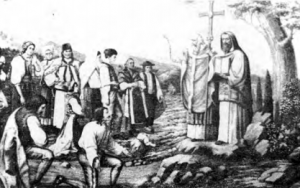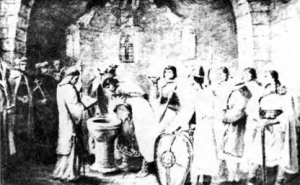Part I: Old World Origins
Historical Background
Although this monograph deals largely with the Slovaks who settled in America, it is altogether appropriate to explore the socioeconomic and political milieu of their homeland for the sake of acquiring both insight into their character and understanding of their motives for emigrating.
Who Are the Slavs?
The Slovaks belong to a wider group of people known collectively as the Slavs. To this group belong also Russians, Poles, Ruthenians, Czechs, Croats, Serbs, Slovenes, Ukrainians, Bulgars, and Macedonians. These people live in Eastern and Central Europe as well as Siberia, and are considered more a language group than a race. This becomes more evident when one notices the differences in their appearance. Some are light-skinned while others are dark; some are blonds and others have brown hair.
Mistaken Identity
Strange as it may seem, when a Slovak came to America, he could not say that his native land was Slovakia. While an Englishman could say that he came from England, an Italian from Italy, a Pole from Poland, and so on, a Slovak who arrived in America between 1867 and 1918 had to say that he came from Austria-Hungary. He could register his language as Slovak, but his country was part of the Austro-Hungarian Empire that had absorbed many nationalities. Because of this enforced affiliation, they were often erroneously referred to by the slang term “hunkies” which is derived from the word Hungarian, and, of course, they were not Hungarian. This also complicated matters for the United States census takers, who did not distinguish between ethnicity, and an ethnic group and a political entity. As a result, we will never know for certain how many Slovaks were mistakenly tabulated as either Austrian or Hungarian or both! (Unfortunately, this confusion was to continue when the Czechs and Slovaks formed a free and independent state which was called Czechoslovakia. Now, if the Slovak said he was from Czechoslovakia, he was considered a Czech or a Czechoslovak and he was neither).
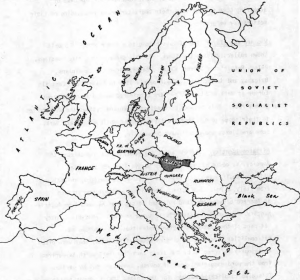
Language
Since Slovak names will be used from time to time, it is perhaps reassuring to note that since the Slovak language is quite phonetic, its pronunciation is not difficult. Also, as a point of interest, Slavic philologists consider the Slovak language a key to Slavic languages: Russian, White Russian, Ukrainian, Czech, Polish, Slovak, Slovenian, Serbian, Croatian, and Bulgarian. Slovak contains the greatest number of forms common to all.
Geography
Today, the ancient homeland of the Slovaks bears an established identity of its own. It is called Slovakia or Slovensko (SLO-ven-sko) in the Slovak language. Slovakia, only a remnant of what it once was, is a relatively small-sized European country with an area of 18,922 square miles and a population a little short of five million people on their native territory. For various valid reasons, there are other millions of Slovaks who, even today, are not in their homeland. Some historians estimate that there may even be more persons of Slovak origin outside Slovakia than there are in it.
Slovakia is in east central Europe where the cradling slopes of the towering Tatry or Carpathian mountains form its northern boundary. The legendary Danube and the Tisa, its tributary, wash much of the Slovak southern border. Poland, the USSR, Hungary, Austria and Moravia (part of Czechoslovakia), are its closest neighbors, each one touching part of the border of Slovakia. In 1918 Slovakia, Bohemia, Moravia, Silesia, and Carpathian Russia were joined into a federated republic called Czechoslovakia, but this did not occur until after the Slovak people bore with great patience and never failing trust in God, one thousand years of dominance by foreign elements.
Stone Age Beginnings
The Slovak people have a history as ancient as early Danubian civilization. Archaeological findings show that by 5000 B.C., Slovakia was an inhabited land. There are also indications revealing that in the oldest stone age (30,000 B.C.), the Nitra region was a cradle of a nascent civilization. These claims are not surprising, for Slovakia is located in the very heartland of Europe. Its geographic position as well as its physical features favored the development of routes taken by nomadic tribes as well as by migrating peoples. Quite naturally then, this region came to serve as a crossroads for the heavy traffic of commerce, for the deployment of military forces, and for the quickening of cultural exchange. By the same token, it also attracted early settlers.
Yet these very assets sometimes proved to be liabilities as well, and the history of Slovakia records a succession of threats to its very existence and survival. At the same time, it also testifies to the surprising resiliency of the Slovak people with their native capacity and their seasoned schooling to endure, to achieve, and to hope even in the face of hopelessness. Periods of historic achievement stand out in vivid contrast to years of bitter oppression and subjugation in Slovak history.
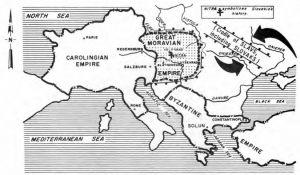
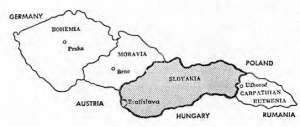
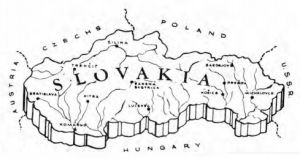
First Slovak State, Seventh Century
After long years under tribal government, the Slavic groups of Europe were effectively united by Samo (623-659 A.D.) who established the first Slavic state in the Morava-Danubian basin. Loose though it may have been, this state is historically significant. Within its structure and by a judicious government, Samo achieved a notable series of victories over the Avars and various intrusive Frankish forces, and extended his kingdom to embrace regions on both sides of the Danube. Under his influence and leadership, the “Slovieni” developed an unmistakable sense of identity and enjoyed a remarkable degree of prosperity. Perhaps, because of this and the Golden Age that was close at hand, the “Slovieni” were able to keep alive the memory of these satisfying periods in the minds and hearts of each succeeding generation as they faced the long years of reverses that were to come, one after the other.
Foreshadowing of Christianity
Some Christian contacts came to this region with early Roman incursions into Danubian lands. This theory is supported by the presence of an inscription carved into a bluff at Trenčín which had been the site of the Roman camp known as Laugaricio. The inscription reads: “In memory of the victory of the Emperor’s army with its 855 soldiers of the II. Legion encamped at Laugaricio. Made by Constantine, Commander of the II. Auxiliary Legion.”
It is relevant to note that Laugaricio’s Legio Fulminans was a Roman contingent that pitched camp in the Trenčín area A.D. 178, and the inscription indirectly celebrates Christian faith and a response to trusting prayer. Because of a long drought, this Roman camp was practically doomed to defeat and extinction until a miraculous answer to the prayer of Christian soldiers in the ranks brought revitalizing rains that saved the parched soldiers and enabled them to recoup strength, fight valiantly, and score a victory in that region. This event is also memorialized on the Triumphal Arch of Marcus Aurelius in Rome.
The Golden Age — SS. Cyril and Methodius
Politically and culturally, the period of the Kingdom of Great Moravia (833-907) was a Golden Age in the history of the Slovak people. By 874 King Svatopluk had consolidated the greatest Slav state of historic times. But, more importantly, in 863 the Greek brothers SS. Cyril and Methodius came to the Slovaks as Christian missionaries at the request of Prince Rastislav. Earlier, Irish monks had engaged in some missionary activity in this area, but their work was not wholly successful. The people did not resist Christianity. On the contrary, they were very much interested and wished to follow the Christian way of life, but it was difficult for them to understand the missionaries who were preaching in a foreign language.
Therefore, the ultimate success of this Christianizing process must be attributed to the apostolic zeal, the sensitive understanding and the scholarly talents of the Greek brothers Cyril and Methodius. The two priests were sent by Emperor Michael III of Constantinople in answer to Prince Rastislav’s appeal for Christian missioners who could instruct his people in their own language. The hope was also expressed, that after their conversion, the teaching of Christ might spread to neighboring peoples.
The saintly brothers devised a special alphabet for the Slavs known as Cyrillic or Glogolic alphabet. Then, they translated Holy Scripture and liturgical books into “Slavonic,” a language that was adopted for liturgical functions until the eleventh century when it was to be lost to the vast majority of Slovaks who were to have the Latin culture imposed upon them. (The Slavonic language was retained by Byzantine Christians, and used in the United States as late as 1950 when it was largely replaced by English because by then the new generations of Americans no longer understood the language.)
Cyril and Methodius not only converted the Slovaks to Christianity, but the brothers also helped to lay the foundation of Slovak culture. They established schools, and with the aid of students and disciples whom they had trained, they laid a solid foundation for a civilization that was to survive even the downfall of Great Moravia.
St. Methodius died in 885 at the time when Slovakia was about to succumb to Hungarian rule. The greatest Slav state of historic times had become vulnerable because of its geographic position. Exposed to the contending forces that kept clashing in a mighty power struggle between the nations of the East and the West, it sustained a long series of changing fortunes. After the battle of Bratislava in 907, Slovakia was no longer an independent state, but rather part of a shifting battleground in the fiercely contested struggle between the Magyars (Hungarians) and the Germans. Finally, in the 11th century, Slovakia was reduced to a vassal principality in the kingdom of Hungary. The Byzantine influence would be lost to the majority of the Slovaks. However, the Christianizing efforts of Cyril and Methodius were not forgotten by the Slovak people. To this day SS. Cyril and Methodius are venerated as the Apostles of all Slavs.
